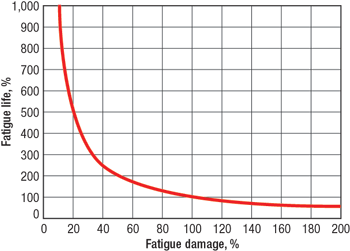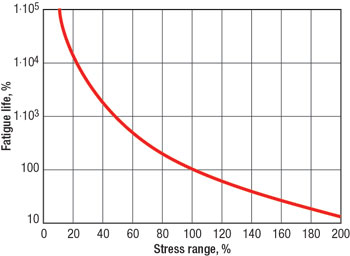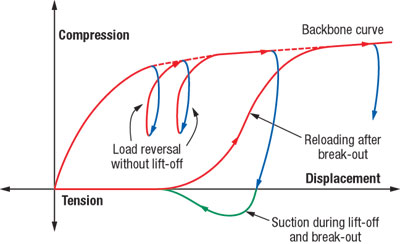Production Technology
Advances in predicting riser fatigue
While an excessively conservative modeling approach provides an added margin of safety, it can also deny operators the most cost-effective riser system for deepwater field developments.
Mark Dixon, DeepSea Engineering & Management, Epsom, Surrey, UK
Steel Catenary Risers (SCRs) offer several advantages in deepwater production. In particular, they are compatible with all host types and can often be the cheapest riser option, depending on specific environmental, field and load constraints. In design terms, however, the issues to consider are few, but complex. As water depth increases, so does the SCR diameter, especially in more hostile environments and with hosts that have limited station-keeping. This creates a design challenge, especially from a fatigue perspective, to the point where costs become prohibitive, or the risks too great, in deep water. SCRs, renowned as a cost-effective option at 5,000 ft, are therefore widely viewed as unviable at depths below 6,500 ft. Now, with the latest advanced modeling, this could change.
Traditionally, because of a lack of precise understanding of the cyclic stresses to which the SCR is subjected, fatigue assessment of SCRs has been highly conservative, erring on the side of extreme caution – given the massive cost of failure. Now, however, where initial analysis indicates insufficient fatigue life in an SCR, advanced riser modeling capabilities independently developed by deepwater consultancy DeepSea Engineering & Management enables more accurate fatigue prediction. This, in turn, avoids excessive conservatism in system design, which optimizes maximum cost-efficiency, while full technical assurance and reliability is retained. SCRs could prove, after all, to be the optimum riser system for some deepwater projects.
MORE ACCURATE MODELING
For more accurate prediction of riser system behavior, the model must account for all the major physical influences. For example, advanced Touch-Down Zone (TDZ) modeling of the riser/ seabed interaction accounts for factors such as trench formation and development, time-dependent and loading-dependent effects of seabed behavior, and varying seabed properties along the riser – none of which are considered in conventional modeling. Equally, accurate pipe-in-pipe SCRs can be modeled, looking at individual representations of the flowline and carrier pipes, and the spaces and gaps between the spacer and inner surface of the carrier pipe. Additionally, the ability to undertake time-domain Vortex Induced Vibration (VIV) analysis using Computational Fluid Dynamics (CFD), coupled with Finite Element (FE) structural dynamic analysis, provides the most accurate modeling and, therefore, the greatest understanding of this cause of riser fatigue available.
Touch-down zone fatigue analysis. Fatigue in the TDZ of an SCR on the seabed is the governing factor in the SCR’s durability, and is heavily influenced by the riser-seabed interaction. This interaction has the greatest uncertainty when modeling SCRs. It is known that this fatigue is proportional to the soil reaction force, which increases with soil rigidity, but complex interactions of the seabed soil composition, its non-linearity, and the random and cyclic nature of loading, combine to make predicting SCR behavior difficult in the TDZ.
The high degree of conservatism in design to address TDZ fatigue is because traditional modeling used in current design practice deploys an elastic (or more crudely, a rigid) seabed, and does not allow for soil softening under repeated loading, despite the fact that this phenomenon is well recognized. While not a problem in more moderate water depths, for deep and ultradeep developments, these conventional, linear seabed models may not allow SCRs to pass minimum fatigue-life requirements.
This advanced riser-seabed interaction modeling draws on published works, including two JIP studies, Carisima and Stride, as well as the company’s own expertise. It allows the influence of physical phenomena on SCR performance to be identified and quantified, including axial friction, lateral resistance, soil suction forces, vertical seabed stiffness, and trench formation and development.
It is believed that most of the fatigue in an SCR’s TDZ comes from the lifting and setting down of this section, where it undergoes repeated bending between zero and the maximum curvature, which changes with seabed stiffness. A small change in seabed stiffness can result in a small change in bending stress, but this causes a significant change in fatigue life, Fig. 1.
 |
 |
Fig. 1. (top) Graph of relationship between fatigue life and fatigue damage. (bottom) Graph of relationship between fatigue life and stress range.
|
|
Accurate modeling is not easily achieved. The soil lying on the seabed-to-water interface undergoes cyclic loading and generally does not obey well-established laws of soil mechanics used in most geotechnical engineering. Moreover, the dynamic motion of SCRs causes repetitive loading and unloading of the soil under the pipe, causing soil degradation and creation of a trench, reaching, in some reported cases, over 100-m long and five diameters in depth, which changes the seabed profile in the TDZ and results in reaction load redistribution on the SCR, significantly influencing its fatigue life, Fig. 2.
 |
Fig. 2. Curves describing soil reaction-displacement relationship during loading-unloading-reloading for typical Gulf of Mexico and West Africa soft, deepwater clays.
|
|
The model, valid for cohesive soils, must therefore take into account all aspects of soil behavior characteristics, such as compressive, unloading, peak-to-peak stiffness, hysterisis and so on, as well as the seabed profile (capable of gradual trench development) and axial variation of soil response through the TDZ.
Field experience. Several projects have been undertaken by DeepSea on behalf of major oil companies to investigate the non-linear soil response on SCR fatigue life. These involved risers ranging from 12 to 24-in. diameter, with and without insulation coating, in over 3,000-ft water depth, for projects in the Gulf of Mexico and West Africa.
Time domain analyses were carried out with regular and irregular sea states using the Abaqus general purpose finite element package, with motions selected to represent a range of floating platforms, including spars, semi-submersibles and FPSOs. Interestingly, these analyses have shown increases in fatigue life predictions ranging from a factor of two to ten, depending on vessel motions, SCR configuration and the seabed soil conditions, although the results do not necessarily support the common belief that non-linear soil with plasticity will always result in less damage.
One study, for example, analyzed an SCR for a West African project. The objective was to provide a comparison with standard riser programs vis à vis the influence of the seabed on fatigue-life prediction, and determine whether accounting for the seabed behavior provided additional margins above the design requirement.
A more precise evaluation allowed greater design freedom for the SCR and avoided undue conservatism, but with technical assurance and reliability. An interesting theme of the findings was the soil reaction patterns, where peak reaction forces are lower for the non-linear seabed than those for an elastic seabed, but they tend to be spread over an increased length of the SCR in the TDZ.
Another project involved a study of the trench profile on SCR fatigue. As the SCR trenches into the seabed, the touchdown point (TDP), and therefore fatigue point, changes location with alteration of curvature at the seabed. It is generally believed that this reduces fatigue damage, as the transition from the curved suspended portion of the SCR onto the section supported by the seabed is more gradual, but the actual curvature at the TDP and its position are governing factors in any fatigue differences between a flat and profiled seabed. Trench depths from three-to-seven diameters will significantly alter the location of the fatigue point, distributing fatigue damage axially along the riser.
Seabed plastic deformation can be important. In extreme cases, during a three-hour simulation, the resultant seabed plastic deflection extrapolated (without accounting for increasing soil stiffness with depth) results in a trench formation rate of about one diameter every two or so days. Such findings can be applied to more accurately determine the influence of the trench profile on fatigue damage.
ACCURACY OPTIMIZES COST-EFFICIENCY
While SCRs offer numerous benefits, design complexity and the disproportionate escalation of technical issues to address in deeper water, plus the inability to demonstrate sufficient fatigue life using conventional modeling, has precluded their use on some ultradeep projects. By enabling the key physical influences, such as TDZ fatigue, to be analyzed and assessed, the latest advanced riser modeling considerably enhances accurate fatigue prediction. Applied at either concept selection/ pre-FEED stage or, more typically, at detailed design stage, this advanced modeling capability can expand the most cost-effective riser design options for a particular field development. 
THE AUTHOR
|
| |
Mark Dixon is technical director of DeepSea Engineering & Management. With an MSc in Offshore Engineering and a BEng in Mechanical Engineering from University College London, Dixon has over 13 years’ experience in the design and project management of pipelines and subsea riser projects. He has extensive project and technical management skills gained through involvement in both projects and new technology development activities and is responsible for all technical output at DeepSea, where his role involves overall management of engineering resources for project activities and R&D.
|
| |
|
|





